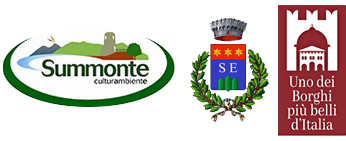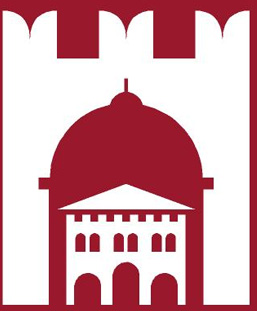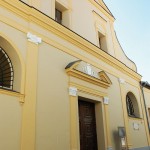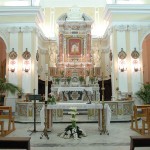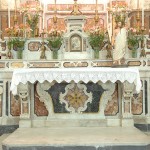Probably built on the remains of a pre-existing church, the current structure dates back to the seventeenth century. and is the result of the Baroque intervention. The main façade, which gives onto via Borgonuovo, is in two orders horizontally articulated by a jutting entablature. The first order is divided into three spans by two Ionic pilasters; in the median, wider, there is a portal framed by pilasters with composite capitals and surmounted by a broken semicircular tympanum (in which an inlaid limestone coat of arms is inserted) that houses the remarkable wooden door (eighteenth century) partly covered from copper foil while in the lateral ones there are two semi-circular windows. The upper Order, consisting of a single central span, encloses two large windows decorated with pilasters on the sides and surmounted by semicircular cornices, offset from the lower portal. To match the orders, two graceful sinusoidal scrolls concave the sides, hiding the sloping roof of the side aisles. It all ends with a classic triangular tympanum with an oculus in the middle.
The interior has three naves, one of which is the tallest one, with pillars adorned with pilasters and Ionic capitals and round arches. Beyond the wide transept opens the terminal apsidal part with the central choir, which houses the main altar, and the adjacent chapels that end the side aisles. The main altar dating back to 1717 (dating back under the arm of a marble torch, dedicated to St. Annunziata, is of extreme elegance and refinement, in polychrome marbles in the colors of Siena, antique red and serpentine green and finely decorated with play of inlays and sculptures, it is enclosed in the jambs by two spirals.
The antependium rises on three steps and is decorated with graceful scrolls on the sides with a cross-shaped frame at the center that encloses a phytomorphic cross. The canteen is surmounted by a two-tiered rung that is soberly inlaid with two volute ends on the end. The ciborium is decorated with scrolled leaves and silver door. The canopy that surmounts the altar consists of two composite marble columns supporting a broken semicircular tympanum depicting the eye of God, with the center, enclosed in a marble frame with scrolls and cartocci and two cherubs at the top, a copy of the painting of the SS. Annunziata affixed recently to replace the original painting on the table of the first half of the fifteenth century, restored and soon relocated.
To complete the architectural system two large angels in papier-mâché of 1700 that each hold a candlestick. The altar is enclosed by a splendid marble balustrade richly decorated with inlays of polychrome marble and semi-precious stones. On the sides of the composition two statues in olive wood (XVII century) depicting a St. Peter holding a book in his left hand and the keys in the right and the other St. Paul holding a sword in his right hand (missing ) and in the left a book. Behind the main altar and along the perimeter apse walls there is the eighteenth-century wooden choir with the seats punctuated by finely sculpted spiral columns. In the upper part there is on the right the painting of the Sacred Heart (oil on canvas of 1937) by Egidio Ducillo, in the middle the picture of the Immaculate (oil on canvas of 1700) by Michele Ricciardi and on the left the painting of the Deposition (oil on foil) of copper 1882) by M. Lenzi.
On either side of the transept there are two marble altars of exquisite 17th century work, surmounted by carved wooden altarpieces, with a spectacular and spectacular architectural composition. Similar in the manufacture, the altars are in polychrome marbles in yellow, antique red, serpentine green and marbled red white and finely decorated with interplay of carvings and sculptures. The central frontals are raised on two steps and are decorated with graceful scrolls on the sides with at the center a mixtilinear frame that encloses a phytomorphic cross. The canteens are in two degrees sober inlaid. The cibori decorated with swirls and festoons. To the capaltari gracious cherubs.
Altar machines are different in architecture. The one above the altar dedicated to the Madonna del Rosario (left side) consists of two Corinthian columns supporting an entablature with a jutting cornice surmounted by a painting depicting the Eternal Father. At the center of the composition, framed by table paintings depicting the 15 mysteries, the painting by Antonio Fusco depicting the Madonna with the Dominican saints, oil on panel dated 1579.
The one above the altar dedicated to the Madonna of Constantinople has a more sober work of the two columns on the sides and ends with a broken arched cimasa with painted half-wings and depicting the Angel on the left and the Madonna on the right; in the middle the oil on canvas painting of the first half of the seventeenth century by the famous Florentine painter Giovanni Balducci, depicting the Madonna with Child, S. Carlo Borromeo and S. Nicola di Bari. As reported by the restorers of the work is the first portrait of Carlo Borromeo da santo.
In the side chapels of the main altar there are:
– on the left altar dedicated to Our Lady of Sorrows with dead Jesus with the respective statues dating back to 1700;
– on the right modern altar dedicated to St. Nicholas of Bari, patron of the Parish, on which rests the silver bust of the Saint dated 1795; on the sides there is the predella of altarpiece “La Maestà” (oil on medieval table) unknown author and the mestoso oil painting on canvas dated 1737 depicting “The Assumption and Saints” of the author Eugenio Vegliante. In the side aisles there are three marble altars surmounted by a stucco aedicula, consisting of pilasters and capitals of composite order that support a broken semicircular arch, which frames the statues or paintings of the venerated saints such as:
Right aisle:
– the Madonna del Carmelo (in the niche there is the statue of the venerated one in olive wood, full trunk, from the 1600s with the child also in olive wood but dating back to 1400);
– S. Colomba di Sens v. and m., of the IV century, with the relics donated by the Holy See in 1600 (in the niche the statue);
– Our Lady of Good Counsel (in the center the oil painting on canvas of 1700 representing the venerated with S. Biagio and S. Antonio Abate, by an unknown artist).
Left aisle:
– altar dedicated to St. Anthony of Padua (in the niche the statue of 1800);
– altar dedicated to S. Rocco (in the niche the statue of 1800);
– altar dedicated to St. Lucia (in the niche the statue of 1600).

